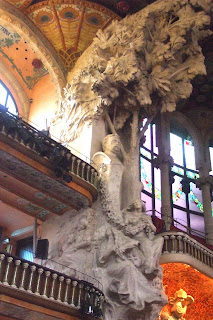The Museu National d'Art de Catalunya is located on Montjuic, a high hill where a former castle/military fortress stands. While the fortress besieged Barcelona with cannons and served as a site of torture, it now houses a military museum. You may take the funicular up the hill, a bus (which we did this time around) or follow the path from Placa d'Espanya, which we did the first time around. If you look at the picture below and spot the two towers near the bull-fighting ring (now a shopping center) you can see Placa d/Espanya. It is a long walk. There are a series of escalators as you reach the foot of Montjiuc that fool you into thinking the hike is not so bad. They are followed by many, many steps. As you might expect the views are quite lovely.
 |
| Looking out to the Placa d'Espanya |
 |
| Looking up at Museu National d'Art de Catalunya |
What makes the MNAC so unusual is not just what is contained in their collection, but how it is displayed. Museu National d'Art de Catalunya has one of the, if not the, best collection of medieval art in Europe. There are many other periods represented in the museum, but I will focus on the Catalan Romanesque art, from about the 11th - 13th c. since that is what we saw.
The museum has a collection of church frescoes which are displayed as they would look if they were in situ. First there is a complicated process of copying the frescoes from the actual site. This involves spraying a particular substance, placing special cloth over the frescoes, applying another substance with a brush, carefully removing the cloth, etc, etc. Quite a lot for me to get my little brain around. Then the museum constructs a 'false' church apse for each of the frescoes from wood covered with some type of plaster. Quite ingenious.
 |
| One of the frescoes |
 |
| This is the back showing the construction of one of the 'false' apses |
|
What I really love about some of this art is the symbolism that is incorporated. Hopefully, you can see that the angel has six wings. This, I believe, is indicative of the Seraphim the highest order of angels. Four of the wings are black, not the traditional red. And Seraphim usually have two wings covering their faces. In this depiction, the four black wings are covered with eyes, probably signifying the eyes of a watching God. Since Seraphim serve as the caretakers of God's throne, that might make sense. This is, of course, merely my own conjecture.
 |
| Angel with 6 wings, note beast at angel's feet. |
There was also a nice display of altar frontal pieces. These have been nicely preserved and restored to their original colors. This is another aspect of medieval religious art that I find interesting. Everything is so colorful. And since not many people could read everything tells a story.
 |
| Jesus is surrounded by his apostles |
 |
| This cheery little altar piece shows the tortured death or several saints. |
 |
| This Jesus is wearing colorful robes. You can see the cross itself is also very colorful. |
There are many wonderful carved figures that are shown as much in context as possible.
 |
| Deposition of Christ |
 |
| You wonder what comprised the rest of the tableaux. |
 |
| Imposing Jesus |
|
|
|
|
|
|
Overall the impact of the exhibition gives a very real impression of
what the church going experience was like during this period. If you are ever in Barcelona I highly recommend it.































